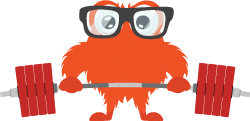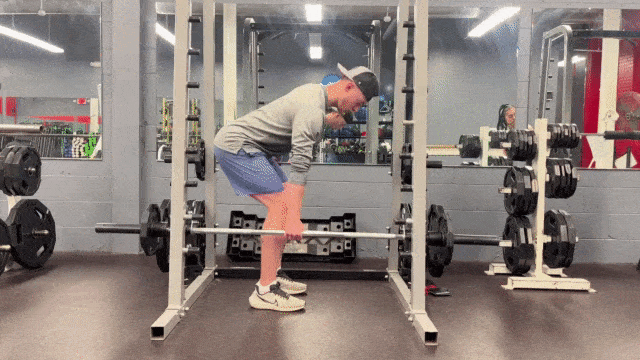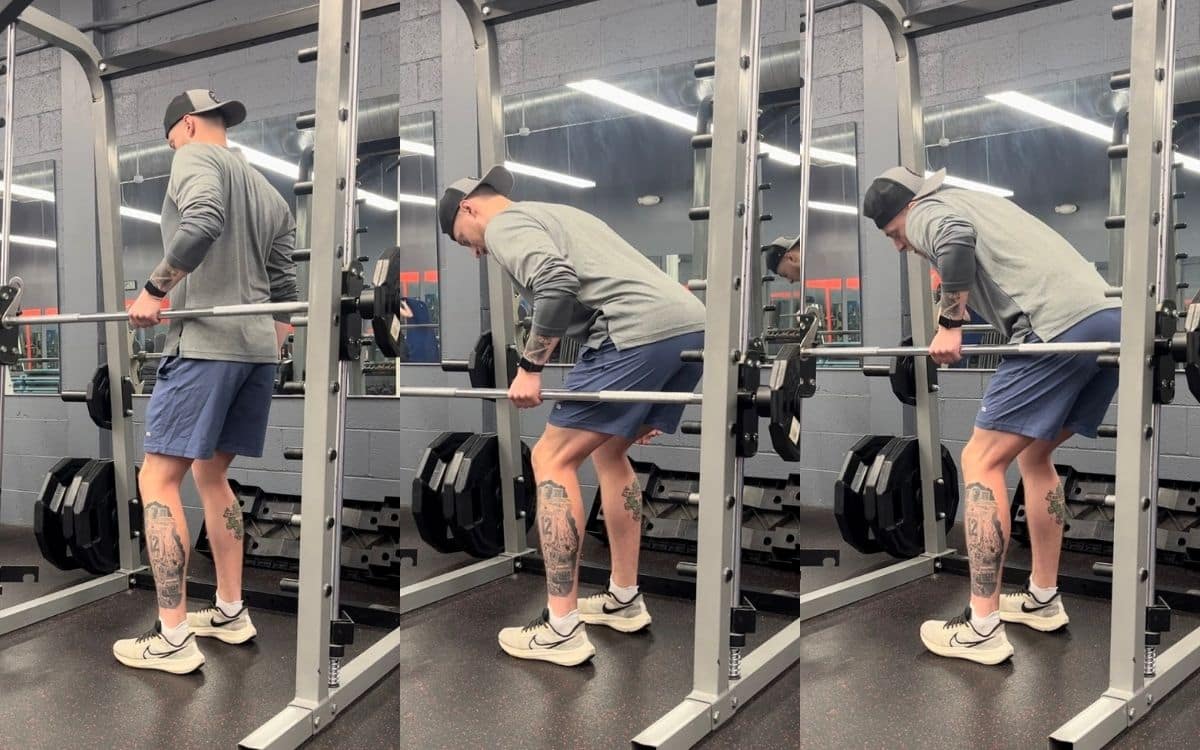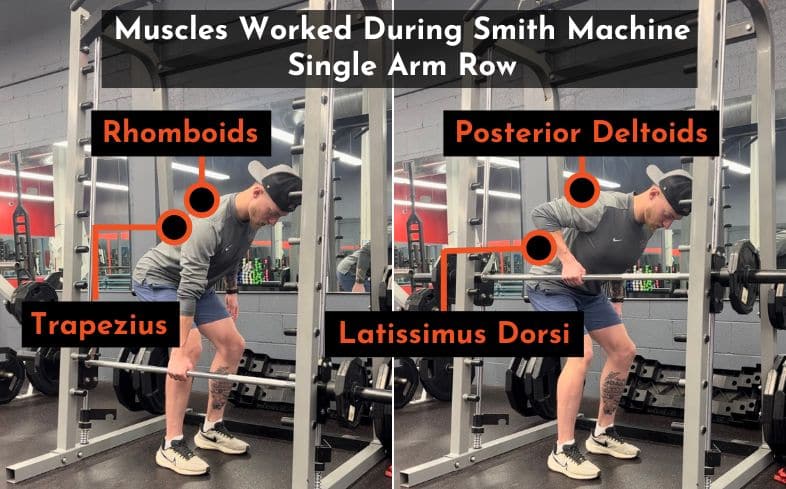The Smith machine single arm row is a rowing variation used to build muscle in the main upper back muscles. This exercise is useful for beginner lifters who need assistance with the bar for technique work and expert lifters who want to overload the muscles with heavy weight.
I use single-arm row variations with many of my athletes and general fitness clients because of their many benefits, like improved posture.
Be sure to check out my full post as I cover how to do the exercise, common mistakes, muscles worked, and some similar alternate exercises!
We've also covered other great back exercises using a Smith machine so you can get a full workout.
How To Do Smith Machine Single Arm Row
Follow these steps below to learn how to do a perfect rep of the Smith machine single arm row:
- Stand parallel to the machine so the barbell is next to your hip
- Hold the center knurling of the bar with an overhand grip; feet shoulder-width apart
- Hinge at the hips slightly so your chest is over your toes and your back is flat with a neutral spine
- Row the bar to the top by driving your elbow up towards the ceiling
- Your bicep will be in line with your torso at the top position
- Return to the starting position by straightening the working arm
Pro tip: Think of the pull being from driving your elbow to the top rather than pulling with your hand. This will reinforce you to use the upper back muscles to row the barbell instead of yanking the bar with your forearms
Check out my article to learn how much the Smith machine bar at your gym weighs to calculate your intensities accurately.
Common Mistakes During Smith Machine Single Arm Row
There are 3 mistakes I commonly see with the single-arm Smith machine row:
Moving The Torso
Many lifters move their torso and rock up to stand tall during the movement. Typically, that means that the upper back muscles are too weak to lift the weight on the bar, so the lifter has to resort to using momentum throughout their entire body. Ensure every rep is controlled with appropriate weight to isolate the upper back musculature.
Not Reaching Full Range of Motion
A shortened range of motion results from too heavy a weight and the lifter rushing through the reps. My coaching philosophy is that every rep needs a full range of motion, or the rep doesn’t count. A good cue to know if you hit enough range of motion with proper form is for your upper arm to be in line or slightly higher than your torso.
Shrugging The Shoulders
When a lifter shrugs their shoulders towards their ears, their upper trap takes over on this exercise. Although single-arm rows target the trapezius muscles, we want scapular retraction to correct our shoulder blades. That way, other muscles, like the latissimus dorsi and rhomboids, get the intended work, too.
For similar exercises, check out how to do a Smith machine row and an inverted row.
How To Add Smith Machine Single Arm Row To Your Workouts
Depending on your gym goals, you can add Smith machine single-arm rows to your workout routine in different ways.
Increase Muscle Size
- If your goal is to add upper body strength and muscle mass, hypertrophy-based training will be the best way to accomplish that goal.
- I recommend doing 3-6 sets of 8-12 reps with a 2-count pause at the top position of the rep with a medium load.
Increase Muscle Definition
- While cutting to increase the definition of your upper back muscles, I recommend doing 1-3 sets of 12-15 reps at a light to medium load.
You can also add a Smith machine conventional deadlift, sumo deadlift, RDL, and shrug.
Muscles Worked During Smith Machine Single Arm Row
There are primary upper back muscles that facilitate the movement, but also secondary muscles that assist in a single arm row. The primary muscles worked in a single arm barbell row are:
- Latissimus Dorsi: The lats are a large muscle that covers your back and are the main muscle used during rowing movements. The lats are responsible for pulling your upper arm toward your torso.
- Trapezius: The traps are a big diamond-shaped muscle across the back. There are 3 parts to the traps: the upper, middle, and lower fibers. The middle and lower fibers stabilize the scapula during a row.
- Rhomboids: The rhomboids are positioned between the shoulder blades and offer stability. They help support the correct position of the scapula during the row exercise.
- Posterior Deltoids: The posterior deltoids are located on the back of the shoulder. They pull your upper arm into extension towards your torso.
The secondary muscles that assist with a single arm row are:
- Teres Major: The teres major is a smaller muscle that connects the upper arm to the scapula. It assists in bringing the upper arm toward the torso.
- Biceps: The biceps are the large muscle inside your upper arm. Elbow flexion activates the biceps to contract. While rowing, they assist in the pull because of the elbow-bending.
- Forearms: There is an isometric contraction of the forearm muscles during a row. They assist in the full movement of a row because you are gripping onto the Smith machine during the entire rep.
For comparison, check out the muscles worked during the conventional deadlift.
Alternatives To Smith Machine Single Arm Row
When looking for alternatives to the single arm row back exercise, we want to do exercise variations that target the same muscles. Two great alternatives to the Smith machine single arm row that I program for my clients are bent-over rows and single arm dumbbell rows on an incline bench.
Bent-Over Rows
Bent-over rows will hit all of the same muscles as a Smith machine row. You will need to make sure you have lots of core engagement through your abs because this variation requires you to be free-standing.
Studies have found this exercise produces the largest lumbar spine load, so I always coach my clients to engage their core to limit lower back pain.
- Stand with your feet shoulder-width apart, holding onto two dumbbells at your hips.
- Hinge at the hips and maintain a neutral spine.
- Simultaneously, drive both elbows to your torso so your biceps are next to your torso.
- Hold this top position for a count of 2, then return to the starting position.
- Ensure your arms are the only moving part during this variation.
Incline Single Arm Dumbbell Rows
Incline single arm dumbbell rows will effectively target your lats and test your grip strength. I like this variation because the assistance of the bench allows me to really focus on activating my lats and pulling with my upper back.
The best angle for lat engagement is 30-45 degrees.
Using 2 free weights, retract your shoulder blades and drive your elbows to your side, finishing the rep with your bicep next to your torso.
Frequently Asked Questions
Is Smith Machine good for rows?
The Smith machine is effective for rows. It provides stability and consistent resistance, making focusing on form and muscle engagement easier. However, due to its fixed path, it offers less natural movement and reduced activation of stabilizing muscles compared to barbell and dumbbell rows.
Is Single Arm Row Better Than Both Arms?
The single-arm row allows for an increased range of motion and precise muscle targeting, making it superior for correcting strength imbalances and enhancing muscle definition compared to bilateral rows. It also engages core muscles for stabilization, offering a more comprehensive workout.
References
Fenwick CMJ, Brown SHM, McGill SM. Comparison of Different Rowing Exercises: Trunk Muscle Activation and Lumbar Spine Motion, Load, and Stiffness. Journal of Strength and Conditioning Research. 2009 Mar;23(2):350–8.
About the Author





